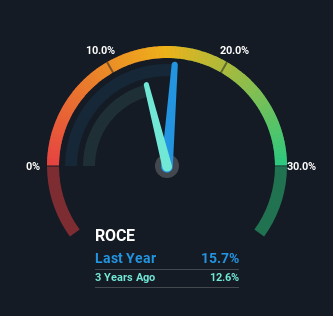- United States
- /
- Media
- /
- NYSE:NYT
New York Times (NYSE:NYT) Is Doing The Right Things To Multiply Its Share Price

What are the early trends we should look for to identify a stock that could multiply in value over the long term? Firstly, we'll want to see a proven return on capital employed (ROCE) that is increasing, and secondly, an expanding base of capital employed. Ultimately, this demonstrates that it's a business that is reinvesting profits at increasing rates of return. So on that note, New York Times (NYSE:NYT) looks quite promising in regards to its trends of return on capital.
Return On Capital Employed (ROCE): What Is It?
For those who don't know, ROCE is a measure of a company's yearly pre-tax profit (its return), relative to the capital employed in the business. To calculate this metric for New York Times, this is the formula:
Return on Capital Employed = Earnings Before Interest and Tax (EBIT) ÷ (Total Assets - Current Liabilities)
0.16 = US$335m ÷ (US$2.7b - US$543m) (Based on the trailing twelve months to June 2024).
Therefore, New York Times has an ROCE of 16%. In absolute terms, that's a satisfactory return, but compared to the Media industry average of 10% it's much better.
View our latest analysis for New York Times

Above you can see how the current ROCE for New York Times compares to its prior returns on capital, but there's only so much you can tell from the past. If you'd like to see what analysts are forecasting going forward, you should check out our free analyst report for New York Times .
What Can We Tell From New York Times' ROCE Trend?
New York Times is displaying some positive trends. The numbers show that in the last five years, the returns generated on capital employed have grown considerably to 16%. The amount of capital employed has increased too, by 35%. So we're very much inspired by what we're seeing at New York Times thanks to its ability to profitably reinvest capital.
Our Take On New York Times' ROCE
In summary, it's great to see that New York Times can compound returns by consistently reinvesting capital at increasing rates of return, because these are some of the key ingredients of those highly sought after multi-baggers. Since the stock has returned a solid 100% to shareholders over the last five years, it's fair to say investors are beginning to recognize these changes. So given the stock has proven it has promising trends, it's worth researching the company further to see if these trends are likely to persist.
One more thing to note, we've identified 1 warning sign with New York Times and understanding this should be part of your investment process.
If you want to search for solid companies with great earnings, check out this free list of companies with good balance sheets and impressive returns on equity.
Valuation is complex, but we're here to simplify it.
Discover if New York Times might be undervalued or overvalued with our detailed analysis, featuring fair value estimates, potential risks, dividends, insider trades, and its financial condition.
Access Free AnalysisHave feedback on this article? Concerned about the content? Get in touch with us directly. Alternatively, email editorial-team (at) simplywallst.com.
This article by Simply Wall St is general in nature. We provide commentary based on historical data and analyst forecasts only using an unbiased methodology and our articles are not intended to be financial advice. It does not constitute a recommendation to buy or sell any stock, and does not take account of your objectives, or your financial situation. We aim to bring you long-term focused analysis driven by fundamental data. Note that our analysis may not factor in the latest price-sensitive company announcements or qualitative material. Simply Wall St has no position in any stocks mentioned.
About NYSE:NYT
New York Times
The New York Times Company, together with its subsidiaries, creates, collects, and distributes news and information worldwide.
Flawless balance sheet with solid track record and pays a dividend.
Similar Companies
Market Insights
Community Narratives



